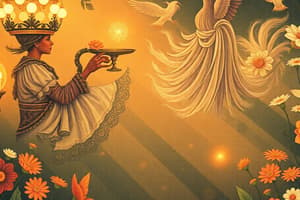Podcast
Questions and Answers
Match the leadership model with its description:
Match the leadership model with its description:
Great Man Theories = Leaders are born, not made. Leaders are heroic and charismatic. Trait Theory = Leadership is based on the personal qualities and characteristics of the leader. Situational Leadership = The style of leadership varies according to the situation and the readiness of the followers. Transformational Leadership = Leaders inspire and motivate followers to achieve a common goal, often through charismatic leadership.
Match the management function with its description:
Match the management function with its description:
Planning = Setting goals and determining the best course of action to achieve them. Organizing = Coordinating resources and tasks to achieve the organization's objectives. Commanding = Directing and leading subordinates to accomplish tasks. Controlling = Monitoring performance and taking corrective action as needed to ensure that organizational goals are met.
Match the managerial role with its description:
Match the managerial role with its description:
Interpersonal Roles = Include roles like figurehead, leader, and liaison, which involve dealing with people both inside and outside the organization. Informational Roles = Involve roles like monitor, disseminator, and spokesman, which involve handling information within and outside the organization. Decision-making Roles = Encompass roles like entrepreneur, disturbance handler, resource allocator, and negotiator, which involve making choices that affect the organization. Operational Roles = Entail roles related to day-to-day tasks and activities within the organization.
Match the definitions of leadership with their sources:
Match the definitions of leadership with their sources:
Match the leadership theory with its description:
Match the leadership theory with its description:
Match the leadership style with its key dimensions:
Match the leadership style with its key dimensions:
Match the historical figure with their leadership power type:
Match the historical figure with their leadership power type:
Match the leadership concept with its description:
Match the leadership concept with its description:
Match the leadership theory or model with its key components:
Match the leadership theory or model with its key components:
Match the leadership theory or model with its situational factors:
Match the leadership theory or model with its situational factors:
Match the leadership theory or model with its key criticisms:
Match the leadership theory or model with its key criticisms:
Match the concept related to leadership with its key attributes:
Match the concept related to leadership with its key attributes:
Match the type of resistance to change with its manifestation:
Match the type of resistance to change with its manifestation:
Match the proposed categories of leadership with their descriptions:
Match the proposed categories of leadership with their descriptions:
Match the approaches to managing change with their proponents:
Match the approaches to managing change with their proponents:
Match the states of change with their coping strategies:
Match the states of change with their coping strategies:
Match the aspects of readiness for change with their emphasis in communication strategies:
Match the aspects of readiness for change with their emphasis in communication strategies:
Match the ways to use resistance to change constructively with their proponents:
Match the ways to use resistance to change constructively with their proponents:
Match the following leadership styles with their descriptions:
Match the following leadership styles with their descriptions:
Match the following themes in authentic leadership with their descriptions:
Match the following themes in authentic leadership with their descriptions:
Match the following attributes of authentic leaders with their descriptions:
Match the following attributes of authentic leaders with their descriptions:
Match the following critical approaches to leadership with their early warning signs:
Match the following critical approaches to leadership with their early warning signs:
Match the following insights about gender and leadership with their descriptions:
Match the following insights about gender and leadership with their descriptions:
Match the following insights about leadership styles and organizational life cycles with their descriptions:
Match the following insights about leadership styles and organizational life cycles with their descriptions:
Match the following approaches to change with their descriptions:
Match the following approaches to change with their descriptions:
Flashcards are hidden until you start studying
Study Notes
- Transformational leadership: a leadership style where leaders provide their followers with a purpose and vision, and identify with them.
- Servant-leadership: a form of leadership that prioritizes serving others, recognizing the distributed power and encouraging leadership development.
- Authentic leadership: a leadership approach based on self-awareness, ethics, and self-regulation.
- Four themes in authentic leadership: natural development, development from struggle, development from a purpose, and an active learning process.
- Attributes of authentic leaders: being true to oneself, humility, empathy, moral courage, and emotional intelligence.
- Critical approaches to leadership: derailing leaders can lack skills in self-awareness, interpersonal skills, business acumen, and leadership. Early warning signs include poor results, narrow perspectives, poor team building, poor working relationships, and inappropriate behavior.
- Gender and leadership: women and men exhibit differences in leadership styles, with women more likely to adopt relational, participative, and transformational styles while men are more likely to take a task/goal-oriented, assertive approach.
- Leadership and change: leadership styles vary depending on organizational life cycles, with a creative and entrepreneurial style often best for evolving markets, and top management styles changing as the organization matures.
- Approaches to change: Dunphy and Stace modeled approaches to change on two dimensions: the level of environmental readjustment needed and the leadership style needed to realign it. They identified three categories: corporate transformation, modular transformation, and incremental adjustment. Fine-tuning is typically at lower levels.
Studying That Suits You
Use AI to generate personalized quizzes and flashcards to suit your learning preferences.



